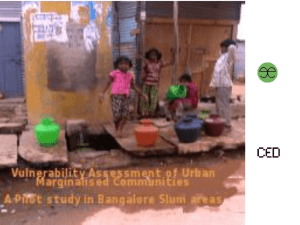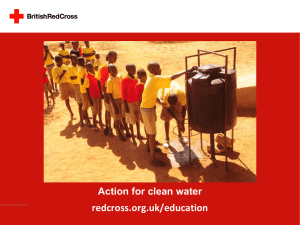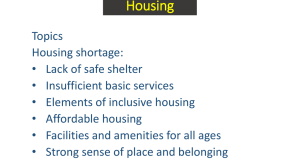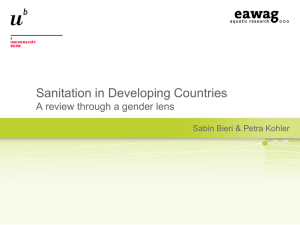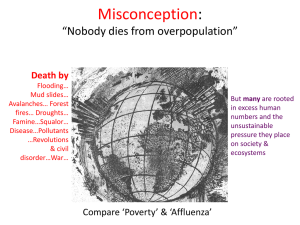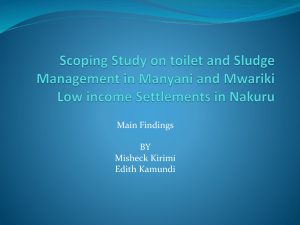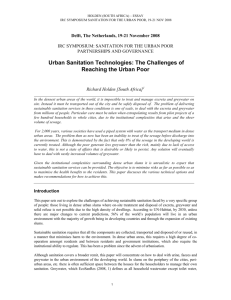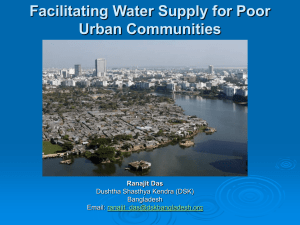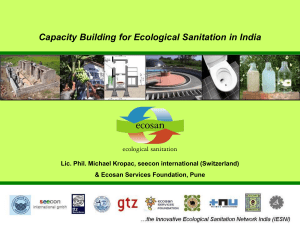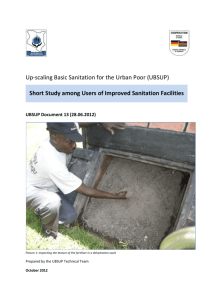C1U1_D_Ecosan_for_Slums_Upgrading - Unesco-IHE
advertisement
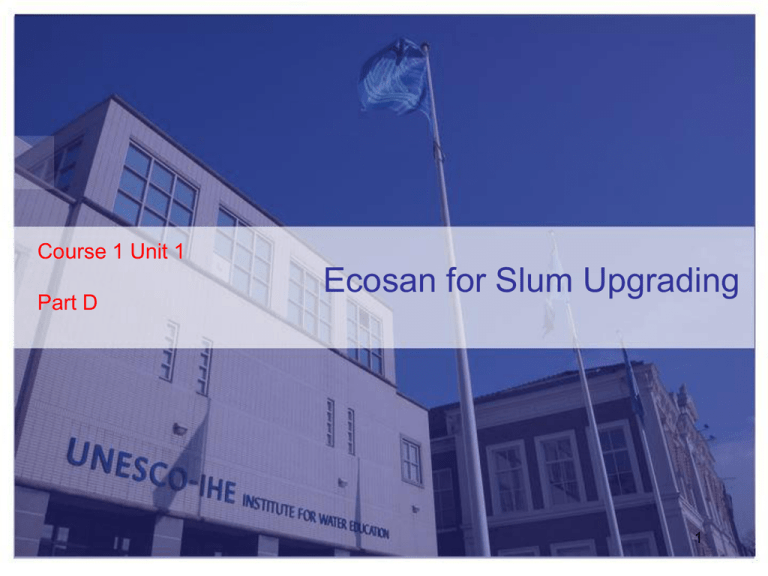
Course 1 Unit 1 Part D Ecosan for Slum Upgrading 1 Slums world wide There are about 1 billion slum dwellers; by 2020 this number is expected to have extended to 1.4 billion(2) What is a slum? There is no internationally accepted definition of a slum. However, an expert group meeting agreed on a generic definition which is recommended for use as: a settlement where inhabitants have inadequate housing and basic services, often not recognized nor addressed by public authorities as an integral part of the city.(2) 2 Slums are characterized by: inadequate access to safe water (if available; cost!) inadequate access to sanitation and other infrastructure; poor structural quality of housing; overcrowding (high density) insecure tenure(2) 3 Sanitation in slums globally http://maps.grida.no/go/graphic/no-shelter-refugees-sanitation-and-slums 4 Upgrading of Slums Slum upgrading is a proactive, efficient and effective way of achieving MDG 7, Target 11 — to improve significantly the lives of at least 100 million slum dwellers by the year 2020. This entails physical, social, economic, organizational and environmental improvements to existing slums. Our interest in this course unit are environmental concerns with a focus on sanitation. 5 Why ecosan for slum upgrading (1/2)? Advantages of ecosan systems compared to conventional sewer-based sanitation (for excreta management*) include: – Lower cost – More flexible – can more easily accomodate rapid changes in population numbers – Not reliant on reliable water supply for flushing – Decentralised approach, easier to involve residents • More user participation in planning process • Ownership and O&M can lie with the locals * For greywater, some form of alternative sewer system may be called for, e.g. Settled sewerage, or home treatment for greywater, like the greywater (mulch) tower – we will discuss this in the greywater units 6 Why ecosan for slum upgrading (2/2)? Advantages of ecosan systems compared to conventional pit based sanitation: – Toilets* can be “portable” therefore providing higher flexibility – No groundwater pollution from excreta – No soil required (can be indoors), no odour and flies, no need to dig – Costs are similar or only marginally higher If space permits: residents can reuse ecosan products as fertiliser to increase food security (urban agriculture) * For example urine diversion dehydration toilets (UDD toilets) 7 CASE STUDY SCUSA- stands for Sanitation Challenges for Unsewered African Mega cities. It is a project whose undertakings currently focuses on Bwaise III, a slum in Kampala Uganda The project is pursuing an integrated intervention approach under 3 disciplines (Sanitation, Hydrology and Socioeconomics) 8 Scusa Project MSc: Sanitary Engineering Objective selection of Sustainable Technology Options PhD Sanitary Engineering PhD Institutional, social and economical aspects PhD Hydrogeology Sanitation limitations in slums (Bwaise III) Sewers are only for richer areas of Kampala (7.5%) (more over trickling filters are used which discharges to L. Victoria) Sanitation: Bwaise III >73% pit latrines are unimproved 10 Sanitation limitations in slums (Bwaise III) Poor housing due to low income status Bwaise III a has a high Pop. density (>27,000Pple/KM2) 11 Sanitation limitations in slums (Bwaise III) Often the area experiences floods on heavy rainy days 12 Sanitation limitations in slums (Bwaise III) Poor access and unhygienic conditions. 13 Existing Sanitation Status in Bwaise III The sanitation facilities from the 400 households sampled are: -Hanging pit latrines which in most cases are emptied into drainage channels (55%) -Traditional pit latrines (18.5%) -VIP latrines do exist but most of them are public toilets which are disludged routinely (25%) - Septic tank systems (1.25%) -No facilities (0.25%) 14 Existing Sanitation Status in Bwaise III 1.25 100% 25 90% None 80% Septic tank 70% VIP latrine 60% 55 50% Hanging pit latrines Traditional Pit latrines 40% 30% 18.5 20% 10% 0% 1 15 Existing Sanitation Status in Bwaise III Ownership of Sanitation Facilities in Bwaise III 15% 10% Public Self (Private) Shared 75% 16 Solid Waste Management-Bwaise III The Solid waste management practices in Bwaise III include: Burning (39.25%) Burying (2.75%) Bushes and open dumping (11%) (The above methods (57%) could pose a health hazard) Private sector and Kampala City Council-KCC (46.75%), do collect and take to a land fill. 17 Solid Waste Management-Bwaise III Solid waste management practices in Bwaise III 39.25 40 33.25 35 30 Proportion of 25 population (%) 20 13.5 15 7.75 10 2.75 5 3.25 0.25 0 Burn Bury Bushes Dump sites Private sector KCC No Solid waste Management types 18 Suggested Remedies For solid waste management: Separation at source (recycling and possibly co-composting) is encouraged For excreta management: Use of environmentally friendly solutions with possible re-use eg. UDDTs, and Bio-latrines could be tried at the periphery of Bwaise III, To check the flooding problem, drainage of the area needs urgent attention Since management structures exist in the area, intensification of health promotion education (CBOs, Village Health Teams & WATSAN committees). Behavioural change is very important 19 Course 1 Unit 1 References for this presentation WHO/UNICEF (2006) Meeting the MDG Drinking Water and Sanitation Target – The Urban and Rural Challenge of the Decade. WHO/UNICEF Joint Monitoring Programme (JMP) for Water Supply and Sanitation. Available: http://www.who.int/water_sanitation_health/monitoring/jmp2006/en/index.html * (1) UN-HABITAT (2003) The challenge of slums – Global report on human settlehttp://www.unhabitat.org/pmss/getPage.asp?page=downloads* (2) A.Y. Katukiza, M. Ronteltap, A. Oleja, C.B. Niwagaba, F. Kansiime, P.N.L. Lens Selection of sustainable sanitation technologies for urban slums — A case of Bwaise III in Kampala, Uganda. Science of The Total Environment, Volume 409, Issue 1, 1 December 2010, Pages 52-62. 20 Course 1 Unit 1 Further reading on urban slums Karki, M. J. (2005) Integrated infrastructure provision for slum areas. MSc Thesis IUE 05-08, UNESCO-IHE Institute for Water Education, Delft, the Netherlands Kalimba, I. (2007) Integrated urban slum infrastructure development : case study of Kigali, Rwanda. MSc Thesis MWI 07.20, UNESCO-IHE Institute for Water Education, Delft, the Netherlands * Useful website: www.web.mit.edu/urbanupgrading Google keyword combination for this topic: urban slum upgrading 21

